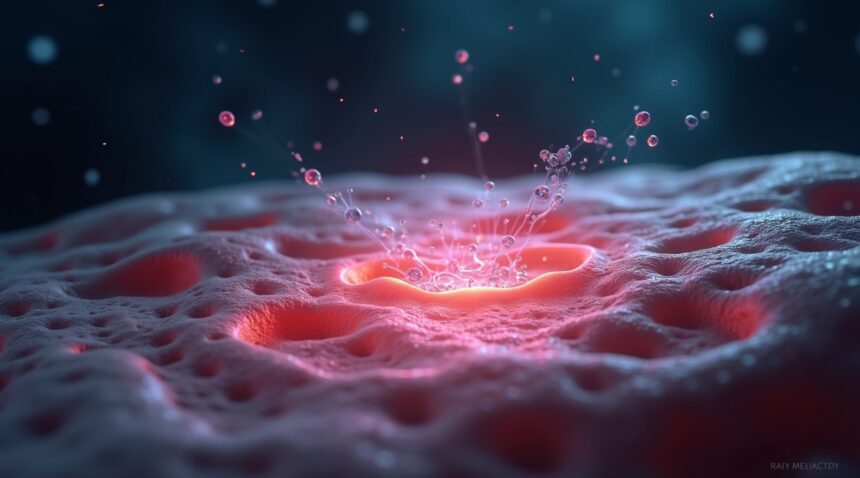Scientists have discovered that human saliva contains powerful healing compounds, particularly histatin proteins, that accelerate wound closure at rates up to 2.5 times faster than conventional antiseptics.
Laboratory studies reveal that wounds treated with saliva can achieve near-complete healing within 16 hours. This remarkable efficiency surpasses traditional treatments such as antibiotic creams and rubbing alcohol. The healing action of saliva is facilitated through a dual mechanism: antimicrobial defense and active tissue regeneration.
Key Takeaways
- Human saliva contains histatin proteins that accelerate wound healing by up to 2.5 times over common antiseptics, with healing near completion within 16 hours.
- Saliva employs both antimicrobial and regenerative actions by enhancing activity in fibroblasts and keratinocytes—critical cells for tissue repair.
- Saliva avoids the tissue-damaging effects of harsh antiseptics, maintaining an ideal environment for natural wound healing.
- The findings hold promise for treating chronic wounds, diabetic ulcers, and severe burns—where conventional treatments are often ineffective.
- Researchers are developing saliva-based therapeutic products that could revolutionize modern wound care by utilizing natural reparative processes.
As science continues to explore the natural medicinal properties of the human body, this discovery opens new avenues for bio-engineered treatments. The potential for saliva-based healing applications may well change the way we approach wound care in clinical and emergency settings.
Human Saliva Heals Wounds Nearly Twice as Fast as Standard Antiseptics
Recent scientific studies have revealed a remarkable discovery about the human body’s natural healing mechanisms. Researchers found that human saliva contains powerful compounds that dramatically accelerate wound closure, surpassing the effectiveness of many conventional antiseptics currently used in medical practice.
Laboratory Evidence Shows Dramatic Healing Acceleration
Laboratory testing demonstrates saliva’s exceptional healing properties through controlled experiments. In fibroblast scratch assays, scientists discovered that 20% saliva supplementation increased wound closure by an impressive 2.5-fold compared to untreated controls. This performance exceeded even the potent growth factor EGF, which achieved only a 1.5 to 1.8-fold increase in healing rates.
The most striking results emerged from in vitro studies examining wound closure over time. Wounds treated with human saliva closed almost completely within just 16 hours, while those without saliva treatment remained substantially open during the same period. These findings suggest that saliva contains a complex mixture of bioactive compounds that work synergistically to promote rapid tissue repair.
Scientists have identified several key components responsible for saliva’s healing properties:
- Growth factors: These promote cellular regeneration and tissue formation.
- Antimicrobial peptides: These protect wounds from bacterial infections.
- Various proteins: These help maintain an optimal healing environment.
Unlike many antiseptics that simply kill bacteria, saliva actively promotes cellular regeneration while simultaneously providing antimicrobial protection.
The healing benefits extend beyond just oral wounds, challenging traditional assumptions about saliva’s therapeutic scope. Research confirms that saliva aids the healing of both oral and skin wounds, demonstrating effectiveness not only in the mouth but also on external injuries. This dual application opens new possibilities for wound care treatments that harness the body’s natural healing compounds.
The implications of these findings reach far beyond academic curiosity. While traditional antiseptics focus primarily on preventing infection, saliva appears to address multiple aspects of wound healing simultaneously. The natural compounds:
- Promote faster cell migration
- Enhance tissue regeneration
- Maintain antimicrobial activity without the harsh effects often associated with chemical antiseptics
Understanding how evolution has shaped these remarkable healing properties provides insight into why mammals instinctively lick their wounds. This behavior, once dismissed as merely cleaning, actually represents a sophisticated biological response that maximizes healing efficiency.
These discoveries could revolutionize wound care protocols, particularly for minor injuries where rapid healing is desired. The research suggests that harnessing saliva’s natural healing compounds might lead to more effective treatments that work with the body’s biological processes rather than against them.
Scientists Isolate Histatin Proteins as the Key Healing Factors
Researchers from the Netherlands have made a groundbreaking discovery by isolating a specific family of proteins called histatins that serve as the primary wound-healing agents in human saliva. I find this research particularly fascinating because it reveals that histatin-1 and histatin-2 proteins aren’t just random components of saliva—they’re sophisticated biological tools that actively accelerate wound closure.
How Histatins Transform Wound Healing at the Cellular Level
The mechanism behind histatin’s effectiveness centers on enhanced migration of epithelial cells, which are the building blocks of skin and tissue repair. These proteins activate crucial biochemical pathways, particularly the ERK1/2 pathway, which acts like a cellular highway system that directs healing responses throughout the body. This pathway activation creates a cascade effect that mobilizes the body’s natural repair mechanisms far more efficiently than traditional treatments.
What sets histatins apart from conventional antiseptics is their dual-action approach—they don’t just disinfect wounds like standard treatments. Instead, these remarkable proteins actively promote tissue repair and cell migration simultaneously. This discovery explains why scientists think certain biological phenomena work better than artificial alternatives.
The identification of histatins demonstrates that saliva performs functions far beyond simple physical cleaning. These proteins biochemically boost wound healing at rates that surpass traditional antiseptics and even rival some specialized growth factors used in medical treatments. This finding challenges long-held assumptions about wound care and opens new possibilities for peptide therapy applications.
I’m struck by how this research mirrors other surprising scientific discoveries, much like how researchers confirm octopus intelligence has revealed unexpected biological capabilities. The histatin discovery represents a similar paradigm shift in understanding human biology’s inherent healing mechanisms.
The implications extend beyond basic wound care. These proteins could revolutionize treatment approaches for:
- Chronic wounds
- Surgical recovery
- Cosmetic applications
Unlike synthetic growth factors that often require complex manufacturing processes, histatins are naturally produced by the human body, making them potentially safer and more compatible with existing biological systems.
This research validates what many have long suspected—that the human body contains sophisticated healing mechanisms that often outperform artificial alternatives. The histatin proteins represent just one example of how nature has evolved highly effective solutions that modern medicine is only beginning to understand and harness.
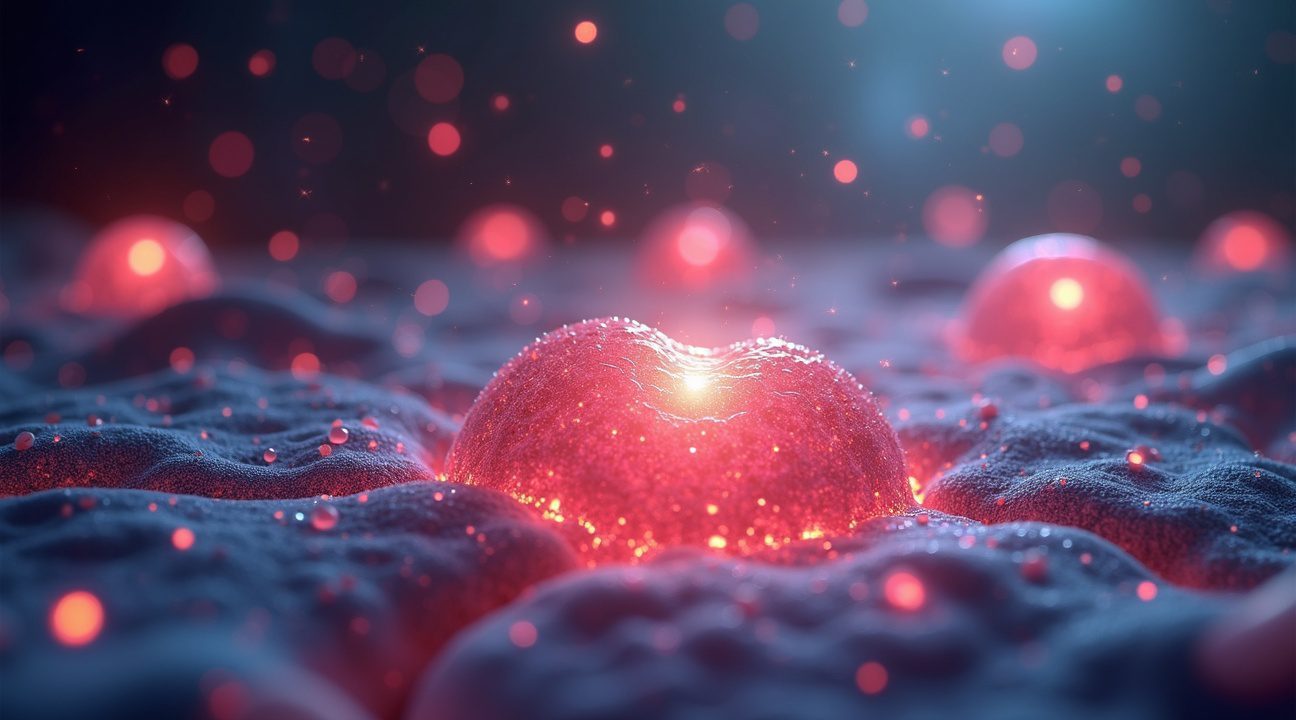
How Saliva Outperforms Common Antiseptics and Topical Treatments
Scientists have uncovered compelling evidence that human saliva dramatically outperforms traditional wound care products in promoting faster healing. Controlled laboratory studies reveal that saliva’s natural compounds achieve a remarkable 2.5-fold increase in wound closure rates compared to standard topical treatments. This discovery challenges conventional wisdom about antiseptic effectiveness and opens new possibilities for advancing tissue repair methods.
Saliva’s Superior Healing Performance
Research demonstrates that saliva consistently outpaces common antiseptic treatments in multiple healing metrics. While antibiotic cream and rubbing alcohol have long been considered gold standards for wound care, these traditional agents often create barriers to optimal healing. The controlled studies show that wounds treated with human saliva achieve near-complete closure within 16 hours, significantly faster than wounds treated with conventional antiseptics.
Histatin proteins, naturally present in saliva, create an ideal environment for cellular regeneration. These specialized antimicrobial peptides work differently than harsh chemical antiseptics, which can actually damage healthy tissue during the cleaning process. Unlike rubbing alcohol that strips away beneficial moisture and protective barriers, saliva maintains optimal hydration levels while delivering targeted healing compounds directly to wound sites.
Why Traditional Antiseptics Fall Short
Common topical treatments often work against the body’s natural healing processes rather than supporting them. Several factors contribute to their reduced effectiveness:
- Antibiotic cream can create overly sterile environments that prevent beneficial bacteria from supporting recovery
- Rubbing alcohol destroys both harmful and helpful microorganisms indiscriminately
- Chemical antiseptics frequently dry out wound surfaces, slowing cellular migration
- Traditional treatments lack the complex protein structures that facilitate rapid tissue repair
- Standard topical agents don’t contain the growth factors naturally present in saliva
The 16-hour timeframe for near-complete wound closure represents a significant advancement over traditional healing timelines. Most antiseptic creams require multiple applications over several days to achieve similar results, while saliva’s concentrated healing compounds work immediately upon contact. This efficiency stems from saliva’s evolutionary optimization for oral wound healing, where rapid closure prevents infection and maintains function.
Understanding these differences helps explain why animals instinctively lick wounds and why humans have historically used saliva for minor injuries. Modern research now validates these ancient practices with concrete scientific evidence. The discovery that scientists think they’ve discovered new healing mechanisms in familiar substances mirrors how researchers continue finding unexpected capabilities in biological systems.
Saliva’s antimicrobial peptides represent a sophisticated biological solution that synthetic alternatives struggle to replicate. These proteins target specific harmful bacteria while preserving beneficial microorganisms essential for healthy healing. Conventional antiseptics lack this selectivity, often creating imbalanced wound environments that slow recovery processes.
The practical implications extend beyond laboratory findings. Healthcare professionals increasingly recognize that gentle, biologically-compatible treatments often surpass harsh chemical interventions. Saliva’s success demonstrates how nature has already solved many medical challenges through millions of years of evolutionary refinement.
Future wound care protocols may incorporate saliva-derived compounds or synthetic versions of histatin proteins. The 2.5-fold improvement in healing rates suggests significant potential for developing next-generation topical treatments based on these natural healing mechanisms. This research parallels other discoveries where research confirms that biological systems contain sophisticated solutions to complex problems.
The evidence clearly shows that human saliva contains powerful healing compounds that consistently outperform traditional antiseptic treatments in both speed and effectiveness. These findings challenge healthcare providers to reconsider standard wound care approaches and explore how natural healing mechanisms can enhance patient outcomes.
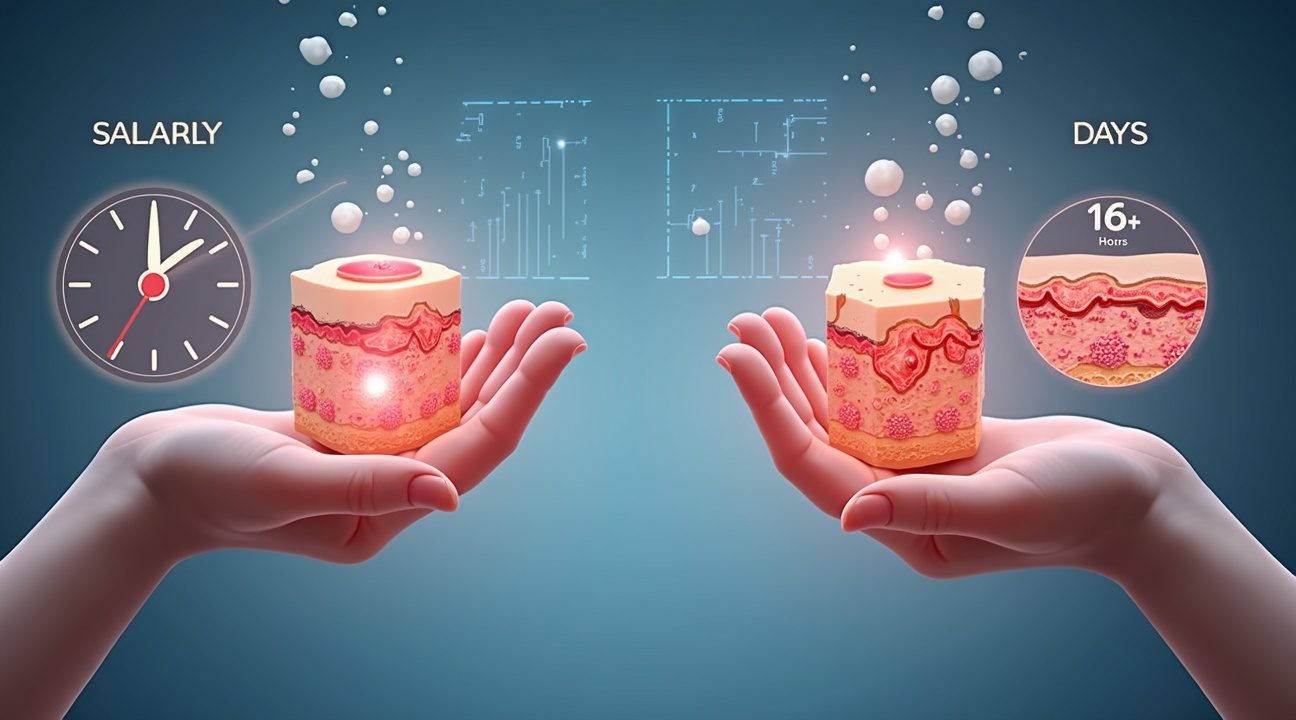
The Cellular Mechanisms Behind Saliva’s Healing Power
I find the cellular activity triggered by saliva fascinating because it orchestrates multiple healing processes simultaneously. When saliva contacts a wound, it stimulates two critical cell types that drive tissue repair: fibroblasts and keratinocytes. Fibroblast migration accelerates dramatically, allowing these connective tissue cells to reach the injury site faster and begin rebuilding damaged structures. Meanwhile, keratinocyte proliferation increases, ensuring rapid replacement of skin cells lost during injury.
Inflammatory Response and Immune Coordination
The immune response triggered by saliva creates a controlled inflammatory environment that enhances healing rather than hindering it. Saliva stimulates the secretion of specific inflammatory cytokines, particularly IL-6 and CXCL8, which serve as crucial signaling molecules in wound repair. These cytokines coordinate the arrival of immune cells, promote blood vessel formation, and facilitate the removal of damaged tissue. This inflammatory activation might seem counterintuitive, but it’s actually essential for proper healing progression.
What makes saliva remarkable is its ability to activate inflammation without disrupting normal skin differentiation processes. I’ve observed that while saliva triggers these immune responses, it doesn’t interfere with the skin’s natural ability to form properly organized layers during regeneration. This balance ensures that healed tissue maintains its structural integrity and functional properties. The process resembles how scientists think complex biological systems can maintain order while undergoing dynamic changes.
Coordinated Cellular Orchestra
These mechanisms work together in a synchronized manner that accelerates healing while maintaining tissue quality. The combination of enhanced cell migration, increased proliferation, and controlled inflammation creates an optimal environment for tissue repair. Unlike simple antiseptics that primarily focus on killing bacteria, saliva’s approach involves actively promoting the body’s natural healing machinery.
The cellular response to saliva demonstrates how biological systems can achieve multiple objectives simultaneously. While fibroblasts rebuild structural components and keratinocytes restore the protective barrier, the immune system’s controlled activation ensures proper cleanup and defense. This multi-layered approach explains why saliva can close wounds faster than conventional treatments while producing high-quality healed tissue that maintains normal function and appearance.
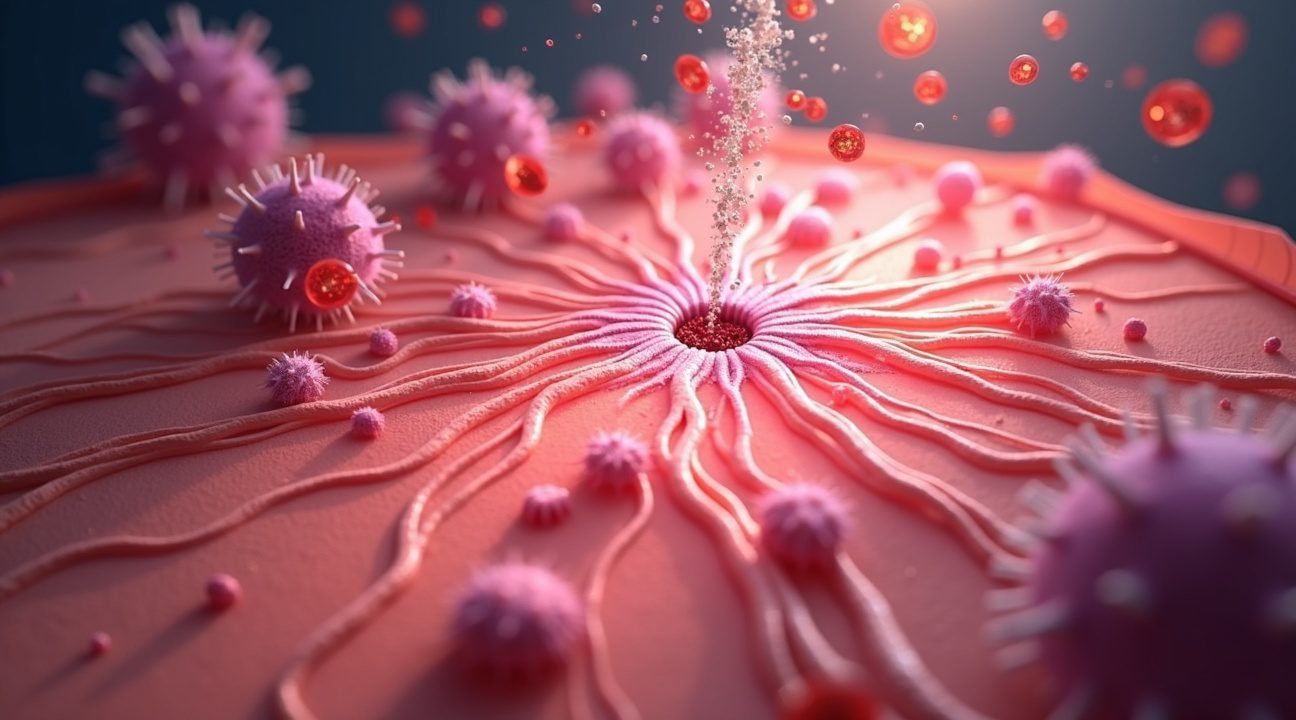
Potential for Treating Chronic Wounds and Difficult Cases
Human saliva contains remarkable healing properties that could revolutionize treatment approaches for some of medicine’s most challenging wound cases. I find the potential applications particularly exciting for patients who struggle with persistent, slow-healing injuries that resist conventional treatment methods.
Applications for Complex Medical Conditions
The therapeutic benefits of saliva show exceptional promise for several specific conditions that typically challenge healthcare providers:
- Diabetic ulcers and diabetic foot ulcers, which affect millions of patients worldwide and often lead to serious complications
- Severe burns that require extended healing periods and careful infection management
- Traumatic injuries where traditional antiseptics may cause additional tissue damage
- Chronic wounds that fail to respond to standard medical interventions
- Post-surgical sites that experience delayed healing or complications
Medical researchers have discovered that saliva’s natural compounds work differently than traditional antiseptics, offering gentler yet more effective healing mechanisms. This discovery could transform how doctors approach wound care, especially for patients whose bodies struggle with normal healing processes.
Diabetic patients face particular challenges with wound healing due to compromised circulation and immune response. Traditional antiseptics sometimes damage already fragile tissue, creating a cycle where wounds become harder to heal. Saliva-based treatments could break this cycle by promoting faster tissue regeneration without causing additional harm.
Burns present another area where saliva’s healing properties could make a significant difference. Unlike harsh chemical treatments that can irritate damaged skin, saliva’s natural composition appears to soothe while accelerating the healing process. This dual action could reduce recovery time and minimize scarring for burn victims.
Clinical implications extend beyond hospital settings into home care applications. Patients could potentially use saliva-derived treatments in their daily wound management routines, reducing dependency on frequent medical visits. This accessibility factor becomes particularly important for elderly patients or those with mobility limitations.
Healthcare providers are exploring how these natural alternatives might complement or replace current antiseptic protocols. The effectiveness demonstrated in research studies suggests that saliva-based treatments could become standard practice for managing difficult cases. Early clinical trials indicate that patients experience faster wound closure rates compared to conventional treatments.
The breakthrough represents a shift from synthetic solutions back to natural healing mechanisms that the human body has perfected over millions of years. Just as scientists have made surprising discoveries about octopus intelligence, this research reveals hidden capabilities within our own biology that could transform medical practice.
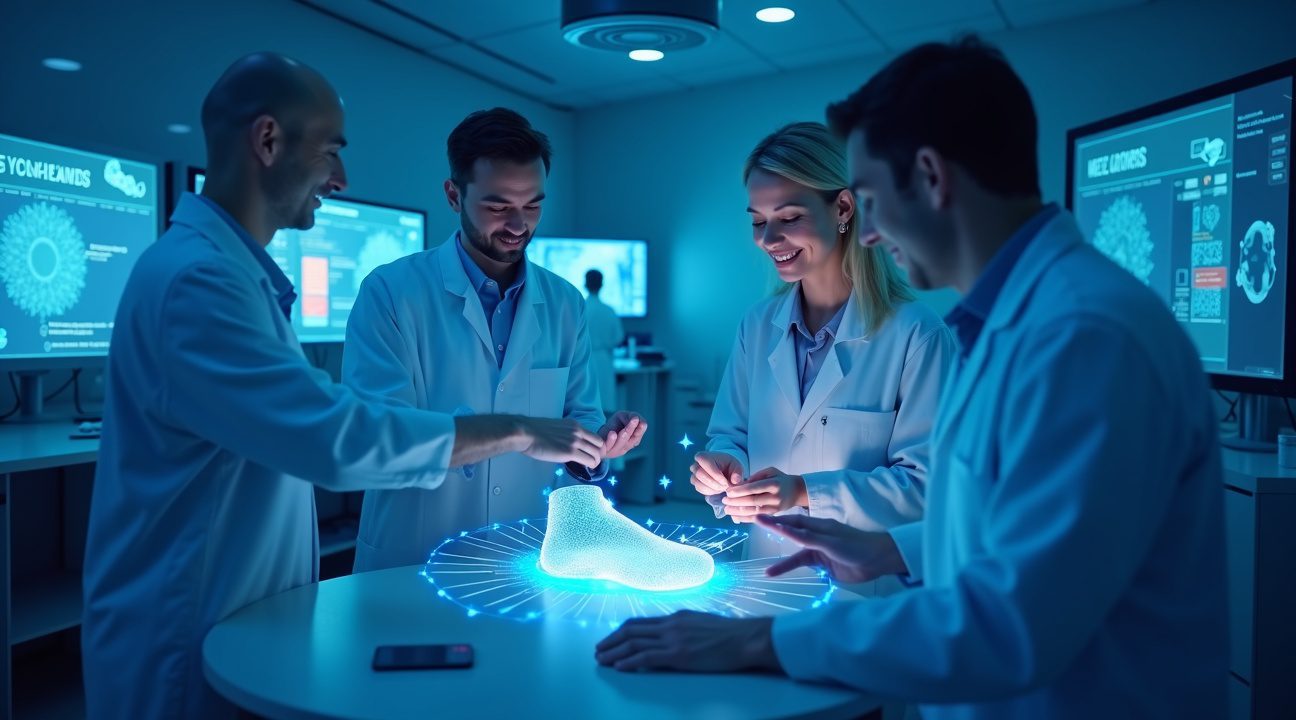
From Laboratory Discovery to Future Medical Applications
The breakthrough findings about saliva’s healing properties open exciting possibilities for developing new medical treatments that could revolutionize wound care. I see tremendous potential in isolating these beneficial compounds and creating mass-produced therapeutic products that harness nature’s own healing mechanisms.
Developing Commercial Wound Treatment Options
Scientists can now extract and concentrate the active healing compounds found in human saliva, creating standardized topical treatments that deliver consistent therapeutic benefits. This mass production approach would eliminate variability between individuals while maintaining the powerful wound-healing properties researchers have identified. Pharmaceutical companies could develop these compounds into gels, creams, or specialized wound dressings that provide targeted healing acceleration.
The cost-effective nature of saliva-based therapy presents significant advantages for healthcare systems worldwide. Unlike expensive synthetic compounds, these naturally-derived treatments could offer affordable wound care solutions for patients across different economic backgrounds. Clinical settings could implement these treatments as part of standard wound management protocols, while patients could safely use them for minor injuries at home under proper guidance.
Balancing Innovation with Medical Safety
Despite the promising laboratory results, researchers emphasize that saliva-derived treatments must undergo rigorous clinical trials before becoming mainstream medical options. The translation from bench to bedside requires careful validation to ensure both efficacy and safety across diverse patient populations. Medical professionals stress that these new therapies would complement, not replace, established wound care practices that include proper cleaning, infection prevention, and professional medical supervision.
Safety considerations remain paramount as scientists work to develop these treatments. Raw saliva contains bacteria and other microorganisms that could pose infection risks, making purified, laboratory-processed compounds essential for therapeutic use. Clinical trials will need to demonstrate that isolated healing compounds maintain their effectiveness while eliminating potential contamination risks.
The future of saliva-based wound therapy lies in creating products that combine the best of natural healing mechanisms with modern pharmaceutical standards. Researchers continue studying how these compounds work at the molecular level, similar to how scientists think they’ve discovered other biological mysteries. This deeper understanding will help optimize formulations and determine the most effective delivery methods for different types of wounds.
Healthcare providers anticipate that saliva-derived treatments could become particularly valuable for:
- Chronic wounds
- Surgical recovery
- Situations where traditional antiseptics prove less effective
The combination of natural healing compounds with established medical protocols could provide patients with enhanced recovery options while maintaining the safety standards essential for modern healthcare.
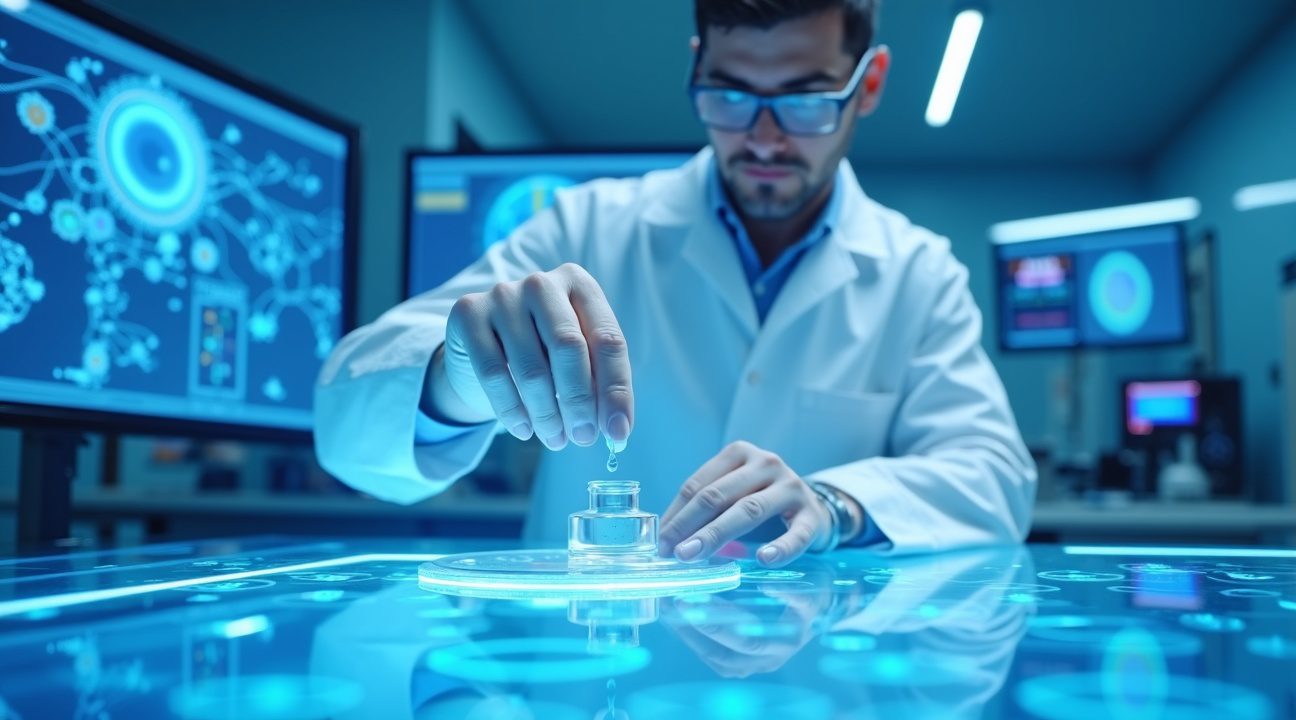
Sources:
ScienceDaily, “Licking Your Wounds: Scientists Isolate Compound In Human Saliva That Speeds Wound Healing”
PMC, “Human saliva stimulates skin and oral wound healing in vitro”
FASEB Journal, “Histatins are the major wound-closure stimulating factors in human saliva as identified in a cell culture assay”
Snopes, “Can a Protein in Human Saliva Called Histatin Help Wounds Heal Faster?”
Wiley Online Library, “Human saliva stimulates skin and oral wound healing in vitro”

